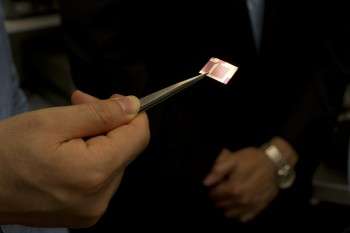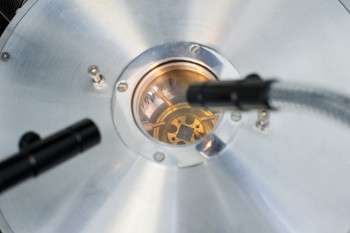A small-scale solution with a large-scale impact

(¬ť∂Ļ“ý‘ļ)‚ÄĒMicrochips are per¬≠va¬≠sive in today's high-‚Äč‚Äčtech society, playing inte¬≠gral roles in the inner work¬≠ings of your cell phone to your Keurig coffee machine.
A pro¬≠cessing tech¬≠nology called CMOS, or com¬≠ple¬≠men¬≠tary metal‚Äďoxide‚Äďsemiconductor, made microchips eco¬≠nom¬≠i¬≠cally fea¬≠sible in the 1980s, said Siva¬≠sub¬≠ra¬≠manian Somu, a research sci¬≠en¬≠tist in Northeastern's Center for High-‚Äč‚Äčrate Nanoman¬≠u¬≠fac¬≠turing.
A crit¬≠ical ele¬≠ment in any microchip is some¬≠thing called an inverter‚ÄĒan elec¬≠tronic com¬≠po¬≠nent that spits out zeros when you give it ones, and vice versa. "A tran¬≠sistor [the basic ele¬≠ment in an inverter] is a simple, extremely fast switch," Somu explained. "You can turn it on and off by elec¬≠tric signals."
In the early days of com­puter tech­nology, mechan­ical switches were used for com­pu­ta­tional oper­a­tions. "You cannot achieve fast com­pu­ta­tions using mechan­ical switches," Somu said. So CMOS, which used elec­tric sig­nals to turn the switches on and off, rep­re­sented a sig­nif­i­cant advance in the field.
But despite its rel¬≠a¬≠tive economy, a CMOS fab¬≠ri¬≠ca¬≠tion plant still costs about $50 bil¬≠lion, according to Somu. "We needed an alter¬≠na¬≠tive, cost-‚Äč‚Äčeffective solu¬≠tion that still can com¬≠pete with CMOS at the foundry level," he said.
CHN's pro¬≠pri¬≠etary "directed-‚Äč‚Äčassembly" approach is that alter¬≠na¬≠tive solu¬≠tion. Instead of requiring sev¬≠eral fab¬≠ri¬≠ca¬≠tion steps of adding and removing mate¬≠rial, as in the case of CMOS, directed assembly is an additive-‚Äč‚Äčonly process that can be done at room tem¬≠per¬≠a¬≠ture and pres¬≠sure. A fab¬≠ri¬≠ca¬≠tion facility based on this tech¬≠nology, Somu said, could be built for as little as $25 million.

This cost sav¬≠ings would make nan¬≠otech¬≠nology acces¬≠sible to mil¬≠lions of new inno¬≠va¬≠tors and entre¬≠pre¬≠neurs, unleashing a wave of cre¬≠ativity the same way the PC did for com¬≠puting, said Ahmed Bus¬≠naina, the William Lin¬≠coln Smith Pro¬≠fessor and Director of the NSF Center for High-‚Äč‚Äčrate Nanomanufacturing.
But cre­ating a nano­sized inverter is easier said than done, added Jun Huang, a post­doc­toral research sci­en­tist in the center. Researchers have using mate­rials like graphene and carbon nan­otubes for cre­ating inverters, but none of these has worked well on its own. Cre­ating a nano­sized inverter made up of dif­ferent nano­ma­te­rials with excel­lent prop­er­ties, Huang said, can result in excel­lent com­pli­men­tary transistors.
Using the directed-‚Äč‚Äčassembly process, the team cre¬≠ated an effec¬≠tive com¬≠pli¬≠men¬≠tary inverter using Molyb¬≠denum disul¬≠fide and carbon nan¬≠otubes. "At the nanolevel," said Huang, "molyb¬≠denum disul¬≠fide occurs in thin, nanometer-‚Äč‚Äčthick sheets." At this scale, he noted, the mate¬≠rial begins to demon¬≠strate tran¬≠sistor char¬≠ac¬≠ter¬≠is¬≠tics crit¬≠ical to the con¬≠struc¬≠tion of a good inverter.
The suc¬≠cess rep¬≠re¬≠sents a step toward CHN's ulti¬≠mate goal of enabling small‚Äď and medium-‚Äč‚Äčsized busi¬≠nesses to develop new, microchip-‚Äč‚Äčbased tech¬≠nolo¬≠gies. The results of their research were reported in a recent article in the journal Nanotechnology.
Journal information: Nanotechnology
Provided by Northeastern University



















